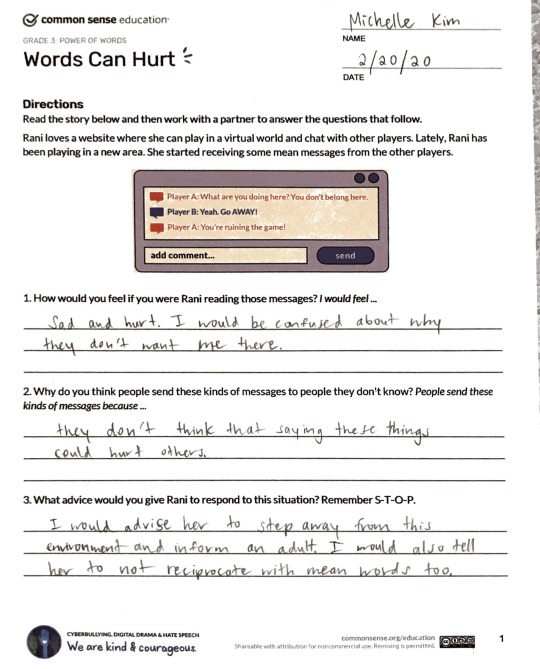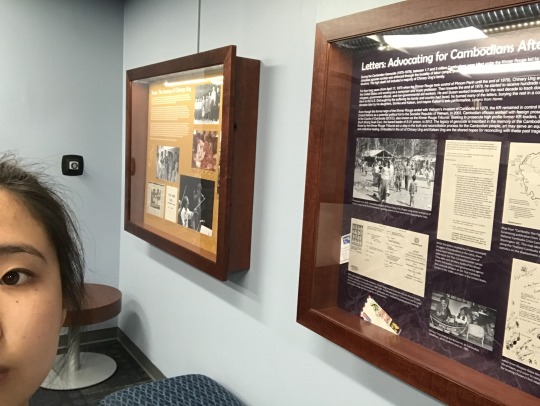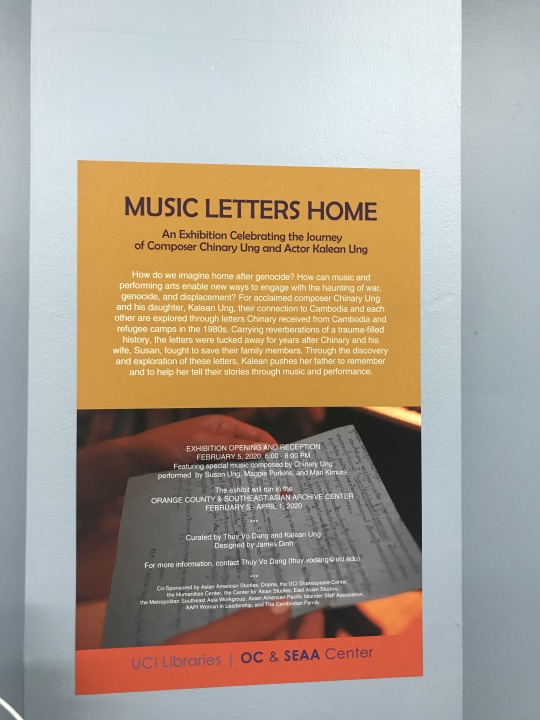Text
Media Lesson Plan
Link: https://www.commonsense.org/education/digital-citizenship/lesson/the-power-of-words
The lesson that I chose to review is one that explores the subject of cyberbullying, with the lesson plan being made for the audience of 3rd graders. The title of the lesson is called, “The Power of Words,” and is meant to be teach young children about how to confront cyberbullying positively, but also about the necessity of empathy. The lesson teaches students to be careful about the words they choose to direct at others, because words can hold a lot of weight. The main aspects of the lesson are “Understand,” “Identify,” and “Decide.” This lesson begins with a warm up activity that introduces the students to how words can be interpreted differently based on how they are received by the audience. The activity also shares the aspect of words being shared online, because interpretations can be different between a face-to-face interaction and a cyber meeting. The next part of the lesson shares a video for the students to watch, which uses characters and a storyline to introduce cyberbullying in a gentle manner. The video’s main message is “STOP,” which is an anagram for “Step away,” “Tell a trusted adult,” “Okay sites first,” and “Pause and think online.” The video shares how empathy and kindness should be used to treat others with respect, rather than mean or harsh words. The next part of the lesson involves a handout titled, “Words Can Hurt,” which involves a scenario of cyberbullying and asks students to answer the discussion questions. The discussion questions directly ask the student of how they would feel if mean words were directed to them, why the cyberbullies would say mean things, and advice that they would give to the bullied girl. The last activity involves a piece of string that divides the room. One side of the strings represents the “OK” side and the “Not OK” side, which students are expected to choose to stand in when answering activity questions.
I think the lesson is very valuable and appropriately oriented to the audience. The audience includes 3rd graders, and they are learning more about how to monitor their behavior. Empathy isn’t something that can be taught with facts, thus it is important to put students in a scenario that exposes them to potential experiences. The video was very gentle in explaining how cyberbullying can affect others, and I like how they brought to attention the truth about the phrase, “Sticks and stones may break my bones, but words can never hurt me.” I also liked how the lesson not only taught the students to confront cyberbullying, but challenged them to think more deeply about how their words and actions have consequences. The activity that used the string in the middle of the room to represent what was appropriate or not is an activity that I actually saw in college. It’s interesting that the same activity that is used to draw in an audience of 3rd graders is also used to communicate with older students. The organization of the lesson was evenly portioned, and I liked the variety of aspects involved. All the parts, such as the warm up, the video, the handout, and the wrap up, all complemented each other well. If there was an imbalance of the parts involved, such as a long handout and no video, then the students might feel disengaged from the lesson. It’s important to have a physical activity that prompts the students to stand and actively participate with their bodies. This allows them to remember the content more clearly, and also helps them see how others perceive the same information given to them as well.


0 notes
Text
UCI Art Exhibition
I visited an art exhibition at UCI that was located in the Orange County & Southeast Asian Archive Center. The name of the event was called, “Music, Letters, Home: An Exhibit Celebrating the Journey of Composer Chinary Ung and Actor Kalean Ung.” In the exhibit, there were letters, documents, pictures, and descriptions that shared about the life of Chinary Ung during the Cambodian genocide. The artifacts displayed provided a deeper window of how dark these times were for Cambodia and its people. I chose to explore this exhibit because my mother once shared to me the history of Cambodia during its genocide, and the theme caught my attention. The exhibit allowed me to read and learn more about the pain and despair that haunted these people through the eyes of just one man. In one of my education classes, we learned in our lecture about aesthetic scanning, which is a thinking routine that challenged the audience to seek more meaning in art in order to connect with the artist. Visiting this art exhibit allowed me to practice aesthetic scanning, especially because I was prompted to truly look at the connections and content that the artifacts provided as a whole. Rather than just viewing the display of the artifacts as just facts in history, the artifacts taught me more about the emotion of the people and the helplessness they felt. I wonder if Chinary Ung now has a deeper peace after the release of these artifacts. His life was in so much turmoil from feeling as if he couldn’t help his people, thus he stored away many of these letters and documents to hide the pain. Now that these artifacts have resurfaced, I wonder if his heart was able to find rest.


0 notes
Text
Beall Center: Aesthetic Center
Visual Literacy-Aesthetic Scanning Exercise
1. What do the records contain, and what is the significance of the colors? Choose three to listen to and describe what you hear.
The records contain audio recordings that encompass the theme of police brutality. Each of the records represent an African-American individual who perished under the hands of police brutality. They contain actual evidence of the sounds that took place during police brutality events for different individuals. The colors in the monument are a mixture of black and white, although white is the dominating color. The only truly black things in the room are the records with the audio recordings. The floor, wall, and stands are all white. The significance of the colors is to portray the dominance of the color white, which coincides with white dominance cultural constructions. The records that are black represent the African-American community that are the subject of hits from the dominating white police. The three records I listened to are Sandra Bland’s, Alton Sterling’s, and Patrick Harmon’s. Each of the records have a mixture of voices, with some that are the individual’s voice and others the voices of either bystanders or the police. Although some parts of the audio recordings are muffled, it shows the reality of the situation in which events turn horribly wrong. There are voices that plead, scream, yell, and argue. Emotions are poured out through the records, and the audience can hear the fear, shock, anger, and terror of the voices that are played.
2. What is the significance of the tables, why are they different lengths?
There are three tables in the room. One table is 21-feet long, another table is 15- feet long, and the last table is 5-feet long. The 21-feet long table is there to represent “The 21 Foot Rule,” which is a rule that justifies a police officer to be able to shoot an individual from this length away. The 15-feet long table represents the event of when Laquan McDonald, an African-American teen, was shot from 15 feet away instead of 21 feet away. The 5-feet long table represents the shooting of Margaret Mitchell, who was only 5 feet away from the police officer who shot her.
3. What is in the file folders? Choose 3 to open up and describe what you see inside.
The file folders each contain legal documents that shared copies of court documents and observations from the trials. The file folders that I opened are from the individuals that I listened from the audio records. Each of the file folders contained documents pertaining to their designated individual. The information included testaments, dates of events, evidence pages, witnesses, court transcripts, and other legal documents that described the events in depth.
What do you “see” (close “scientific” observation)?
What is the story or visual narrative presented? Is it abstract or representational (figures and recognizable objects)? Explain:
The visual narrative that is represented is one that shares the theme of police brutality and the disturbing effects it leaves due to the division of white dominant racism and African-American individuals. The narrative is more representational, especially due to the heavy symbolism portrayed throughout the exhibit. Some symbolism included are the color contrast of black and white, the different lengths of the three tables, and the record disks that represent the lives/voices of the victims.
What is the medium (paint, metal, stone, photography, video, etc.)? How has the artist/sculptor used the “tools” of the artist? Describe the “elements”: color, value, line, texture, shape, form, space. Describe how these elements are organized in the composition: unity, contrast, repetition, balance, etc.
The medium incorporates a mixture of sculpture, and audio-usage. When you first enter the exhibit, there is a large piece of two human bodies that are posted onto the wall. On the bodies of these people, there are bullet holes to represent the places where the victims were shot at. The sculptures aspect includes the tables and the record standings in the room. These sculptures are representative and symbolic. The audio-usage, an interactive sound installation, is contained in the record disks, where the stories of the individuals and the police brutality that they faced could be heard. The artist used the “tools” by providing not only a visual display, but audio displays to show further emotion and realism of events. The spacing, size and placements of all aspects of the art were carefully utilized to convey the messages.
The “elements” include:
- Colors: White and black
- Value: The brightness of the color white and the darkness of the color black. They contrasted drastically against each other.
- Lines: The lines can be found on the floor, from the straight lines connecting the room sections to each other, and the lines that went around on the top of the record disks.
- Texture: Textures were mostly smooth, such as the tables and the record disk tops.
- Shape: The shape of the art came differently, such as in the record disks and tables.
- Form: Two forms taking place include the audio form and the visual form.
- Space: The different parts of the room were spaced mainly into three sections. One section held the drawing of the bullet holes, the other section had the interactive sound systems, and the third section had the file folders and tables. The record stands were all evenly spaced from one another.
The elements organized in the composition include:
- Unity: Unity existed in the drawing with the bullet holes and the collection of record stands clustered evenly together.
- Contrast: The contrast was strong, especially between the colors of black and white.
- Repetition: The record stands were repeated aligned in rows.
- Balance: There was not much balance, due to the white color overwhelming the black color.
- Emphasis: There was an emphasis of the white color inside the room, and different emphasis of the lengths of the tables.
- Pattern: There weren’t much strong patterns.
- Movement/Rhythm: The movement/rhythm can be found at the record disks, which moved in order to deliver the sounds from the audio files.
- Proportion/Scale: The tables were scaled at different lengths, and proportioned to display the symbolism.
What does it mean (interpretation)?
All art is communication, a “conversation” between the artist and the viewer. What is the title of the work? Does this help explain the “artist intent”?
The title of the work is, “American Monument.” The helps the explain the artist intent by raising the underlying issues within America, such as heavy police brutality and the lack of change for the better in the relationship between African- Americans and white police. The title is a little vague, however, and can be reworded to be stronger in delivering the message.
What is the date of the work and what does this tell you about the historical and/or cultural context of the work? The date of the work is 2019, and the exhibit is open October 05, 2019 to April 04, 2020. The date tells the audience that the issues addressed in the art are issues that have been repeated and active within current and past history. History and culture have not changed entirely as anew, and there are things that need to be changed, made aware, and prompted to upgrade for the better.
What does the work mean to you? What is your emotional and intellectual response to the work (there are no wrong answers)? If you had choices why did you select this work?
The work opened my eyes of the emotional aspect of the issues. I was moved by the reality of the situations and the injustice that the individuals faced in their helplessness. The symbolisms throughout the exhibit struck my interest, and I was more inclined to listen to the stories that the records held. My intellectual response to the work is that police brutality is a horrible culture that is still alive today. Selecting this work as a class made me realize how limited and ignorant I am to events that happen all over the world. Living in oblivion and refusing to acknowledge that our world is broken and hurting is selfish and careless of me.
Is it any good (judging)? How do you know? Explain:
The monument was very effective in delivering the aim of its message. Its interacting sound aspect and the representative sculptures were captivating and active in informing the audience of the serious matter at hand. I thought that the monument fulfilled its purpose of exhibiting the pain of police brutality, and the fact that we can’t treat these things without reality.
What else do you want to know about this work of art, what do you wonder?
One thing I wonder about the art was how the artist was prompted to think of all the symbolism and representative ideas. I also wonder how long it took for the artist to gather copies of the documents and audio files and compile them together.

0 notes
Text
Video Game Storyboard - EDUC104E
Our video game is a cooking and finance game directed towards 2nd graders in order to help them practice their subtraction and addition skills. This mathematical topic is a subject that students tend to struggle with during their K-12 schooling, which is why practice is important. The game begins with the user being prompted to select ingredients and tools to complete an order, such as fries and a fryer. The user is then expected to tap and swipe on the game in order to complete the “cooking” aspect of the game. The “finance” aspect comes after the user is done cooking an order, and is getting ready to charge the customer for their order. The customer offers cash to the cashier, and it is the user’s job to return the correct amount of change back to the customer. If the correct amount of change is returned after a certain amount of rounds, the user will be rewarded with praise and a new menu item to make the game more interesting and challenging. Our video game includes scaffolding in the sense that there is a tutorial at the beginning in the form of arrows to help guide the user. After the tutorial, the user is expected to replicate what they learned from the tutorial. If the user needs help after the tutorial, helpful hints and tips will be offered after a minute of inactivity. Our video game addresses Gee’s learning principles by incorporating sub-aspects of each principle within the game. Gee’s learning principles include “Empowering Learners,” “Problem-Based Learning,” and “Creating Deep Learning.” The “Agency” aspect of “Empowering Learners” is displayed when the user is prompted to select certain ingredients and tools for an order. By having the responsibility to choose the correct ingredients and corresponding tools, the user is enforcing the idea that they are a co-designer in the game. The “Well-ordered Sequencing” and “Information” aspects of “Problem-Based Learning” are demonstrated in the game by the user being guided through their duties with the tutorial, helpful hints, and tips. The user progresses through the game in steps that require a sequence, and when the user is stuck they are provided information to help them move forward. The “System Thinking” aspect of “Creating Deep Learning” is explored throughout the game by its journey. The user is challenged not only to implement mathematical knowledge and practice, but to also follow directions and a certain way of completing a job. The goal of completing an order can only be completed if the user completes all the steps properly, thus it is important that the user follows directions with precision.

1 note
·
View note